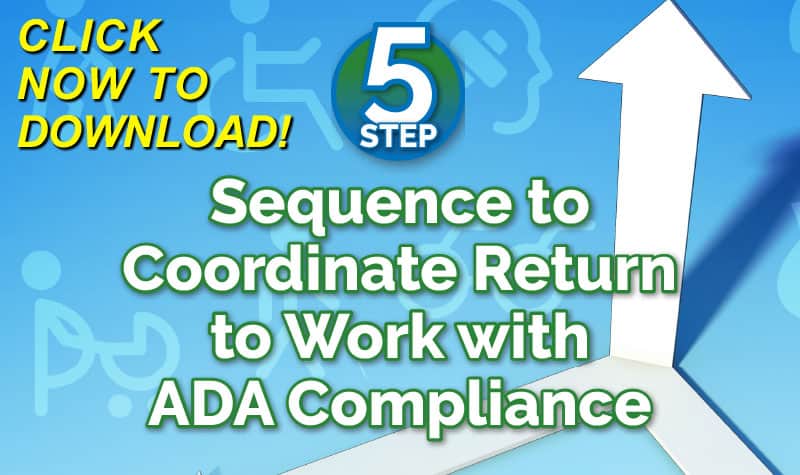Employers Must Begin Interactive Process for Return to Work Sooner Than Thought
Dated: December 4, 2014
[WorkCompRoundUp is authorized to provide this information on behalf of EEOC’s Aaron Konopasky, JD and Jennifer Christian, MD.] EEOC’s Aaron Konopasky, JD and Jennifer Christian, MD Provide Guidance on When Employers Must Start Discussion Regarding Return to Work Accommodations This may be surprising news for some readers: In workers’ compensation, MMI should not be viewed as the trigger for ADA-related protections and obligations.
Background: A common practice in workers’ compensation claims management may not be legal. Employers / claims organizations that postpone the reasonable accommodation process until an injured worker’s medical condition has reached MMI (maximum medical improvement) may be violating the ADA, now that the definition of “disability” has been broadened. Prior to MMI, if medical restrictions have been established by the treating physician, employers often decide whether to offer temporary transitional work without involvement of injured workers. If not, the workers remain out of work – and may end up losing their jobs. Jennifer Christian, MD, MPH who chairs ACOEM’s Work Fitness & Disability Section, asked Aaron Konopasky, JD, PhD, a senior attorney advisor to the EEOC about this. She was surprised to hear that the ADA does apply at any time – whenever a medical condition has the potential to significantly disrupt an employee’s work participation. This means that injured workers will need to be active participants in their employers’ stay-at-work and return-to-work decision-making process. Christian and Konopasky agreed to co-author a brief summary of the way these two programs interact during the post-injury period, which appears below. Please forward this on to anyone who needs to know.
Click Link to Access Free PDF Download
“5-Step Sequence to Coordinate Return-to-Work with ADA Compliance”
In the Worker’s Compensation context, ADA-related issues can arise at any of several points along the injury management timeline. As a practical matter, employers should be pro-actively evaluating and managing Worker’s Compensation and ADA legal issues concurrently.
This is because an employer’s reasonable accommodation-related obligations begin as soon as the employer knows that an individual worker is having trouble at work because of a serious medical problem. By definition, if a doctor informs the employer that a worker has medical restrictions/limitations due to a work-related condition, whether or not the employee is actually working, the employer is now aware that a medical problem is having an impact on the employee’s ability to work. If the condition has the potential to significantly disrupt the employee’s work participation, the employer should immediately engage the worker in an interactive process to look for a reasonable accommodation under the ADA.
Although the employer can stop at this point to determine whether the individual is a “qualified individual with a disability,” it may not be worthwhile. Since employees with workers’ comp injuries are already employed at the time of injury, one can presume they meet the requirement of being “qualified” for the job. And, under the much broader standards established by the ADAAA, any conditions serious enough to require medical restrictions/limitations for more than a few days or weeks (and even some conditions that have not yet caused any work disruption) are likely to meet the definition of an ADA “disability.” An extended inquiry regarding the applicability of the ADA could result in unnecessary delay during a critical period.
Thus, whether or not the worker’s condition is stable and has reached maximum medical improvement (is at MMI) has no relevance, either (a) to the time when the employer’s obligation to engage in the interactive process begins or (b) to the time when a worker should be considered a qualified individual with a disability under the ADA. For more details about specific times when the ADA may apply, read below.
1. At the time a person is injured.
No matter whether the resulting condition is already stable or is still evolving, the ADA may require the employer to provide a reasonable accommodation that would enable the individual to perform his or her essential job functions, unless doing so would involve significant difficulty or expense. Examples might include specialized equipment, removal of non-essential job functions, and special scheduling. Individualized assessment is a key precept of the ADA, so a blanket policy is not appropriate. Employers might also choose to reduce job demands or productivity expectations on a short-term basis, although this would not be required by the ADA. It should be noted, though, that the ADA cannot be used to deny a benefit or privilege to which the employee is entitled on a separate basis. If, for example, the individual has other types of leave available at his or her discretion, whether paid (such as vacation leave) or unpaid (such as FMLA leave), the employer cannot deny that leave based on the fact that he or she could remain on the job with a reasonable accommodation.
2. While recovering out of work due to injury
The ADA may apply as soon as the worker’s condition becomes stable enough that on-the-job reasonable accommodations might allow the individual to perform the essential functions of the job (whether or not there has been a formal declaration of MMI). A blanket policy is not appropriate at this juncture, either. At this point, the employer should re-engage the interactive process to determine whether a reasonable accommodation would allow the individual to return to their usual job. As mentioned above, employers might also choose to reduce job demands or productivity expectations on a short-term basis, although this would not be required by the ADA.
3. When the individual has exhausted his or her leave and workers’ compensation benefits, and is still unable to return to the original position, even with an on-the-job reasonable accommodation.
At this point, whether or not the medical condition has reached MMI, the employer should consider other forms of reasonable accommodation, such as additional unpaid leave or, if the individual is not expected to regain the ability to do the essential functions of his or her current position, reassignment to a vacant position (if one is available). Again, a blanket policy is not appropriate.
In summary, legal obligations under Worker’s Compensation and ADA legal issues should not be assumed to be sequential, because they may run simultaneously. Duration is not the key issue; the main issue is the nature of the condition and its impact on the ability to function at work.
CLARIFICATION To MEMO dated December 4, 2014
Dated: December 11, 2014
The EEOC’s Aaron Konopasky and I were glad to see many thoughtful comments in response to our message about the ADA in workers’ compensation last week in the forums where it was posted. Our summary was primarily written to dispel two common myths:
- In workers’ compensation, the time to think about the ADA is at MMI. This is NOT true. MMI is late among several points in the post-injury timeline when the ADA needs to be considered.
- The ADA’s requirement for an interactive process doesn’t apply in decision-making about transitional work assignments. This is NOT true. Injured workers do need to be active participants in the workers’ comp stay-at-work and return-to-work process.
However, based on the comments we have received, we want to clarify that the ADA has several other significant implications for how employers should respond to existing employees who develop health problems. The ADA is about civil rights for people with disabilities, not financial benefits of one kind or another. The fundamental purpose of the ADA’s employment provisions is to help people with disabilities get and keep jobs, as long as they are qualified to do the work and can meet productivity standards. The cause of the disability is irrelevant. It does not matter what other types of policies or programs are also involved — whether workers’ compensation, FMLA, sick pay, or disability insurance programs. A disability can be newly acquired, transitory, fluctuating, progressive, or longstanding and stable. It can be the result of injuries, illnesses, congenital conditions, or the natural aging process. The only relevant question is whether the disability is now or is perceived as potentially having a significant impact on someone’s ability to perform their job, take home their regular paycheck, and stay employed.
Here are 5 more practical implications for management of ALL types of health-related employment situations:
- As the Federal agency that enforces the employment provisions of the ADA, EEOC’s biggest concern in situations involving disability leaves of any type will be that someone with a disability is being forced to take leave even though he or she could do the essential functions of the job with a reasonable accommodation. Everyone involved in the decision to keep someone out of work — doctors, third-party benefit administrators, managed care companies, workplace supervisors and employee program managers — should keep that fact firmly in mind so that people with disabilities are not needlessly forced out of the workplace.
- Only the employer is accountable for complying with the employment provisions of the ADA. However, treating physicians and the employer’s vendors (benefits claims administrators, managed care companies) who fail to communicate with the employer during the stay-at-work and return-to-work process may be exposing the employer to increased risk/liability. When a vendor or a doctor (especially one who has been selected by the employer) fails to notify the employer that an employee described difficulty working or an adjustment that might allow them to work, the employer could be held liable for failing to provide that accommodation — even though the information was never properly passed along. Doctors and vendors also can help educate employees and small or unsophisticated employers to ensure that the law is followed.
- Some employees may express the desire to remain on leave, rather than return to work with a reasonable accommodation. Of course, employees with disabilities must be allowed to use accumulated sick or annual leave, just like any other employee. And they may have a legal right to insist on leave if, for example, they qualify for FMLA. But if an individual with a disability has no discretionary leave, and a reasonable accommodation would allow performance of job functions in a manner that is safe and consistent with his or her medical needs, then the employee may be required to return to work with the accommodation.
- Paying people money to sit home who are well enough to do something productive does not count as a reasonable accommodation under the ADA, especially when they were not part of the decision-making process that has put them out of work. The employee must be actively involved in arranging any temporary or long-lasting adjustments to their usual jobs in order for the employer to meet the interactive process obligation. With respect to specific cash payments made under workers’ compensation—
A. Temporary Total Disability (TTD) Benefits – There is little difference between cash payments under workers’ comp TTD and disability benefit programs for personal health conditions except how the amounts are calculated. Employees are usually receiving them for one of four reasons:
- The doctor wrote “no work” because their patient’s medical condition is so severe or unstable that it is unsafe for them to do anything except try to get better;
- The doctor wrote “no work” because of a perception that the employer cannot or will not provide safe and suitably modified work on a temporary or long-term basis;
- The doctor released their patient to work with restrictions, but state or federal law, or a union contract means that the employee cannot work until fully able to do the essential functions of their job, so the employee is put out of work temporarily.
- The doctor released their patient to work with restrictions, but the employer said they cannot meet those restrictions (cannot find appropriate work to assign them within their current work capacity) so the employee is put out of work.
In all but # 1 above, the ADA may apply. However, the employee is often not consulted as these decisions are being made. As stated above, giving the employee money is not a reasonable accommodation, and the ADA requires that the employer interact with the employee in looking for a solution that will enable the employee to stay at work.
B. Other types of cash benefits: Temporary Partial Benefits, Permanent Partial Benefits and Permanent Total Benefits -These cash awards help compensate employees for economic loss as a result of their injuries. However, as stated above, giving people money is not a reasonable accommodation, and does not accomplish the public purpose of the ADA.
5. Employers sometimes limit the length of transitional work assignments (TWA) in order to avoid them turning into required permanent accommodations or becoming subject to union job bid rules. To avoid ADA liability, a “usual” 90-day limitation policy that provides for an individualized assessment of the individual’s situation and possible extension is more appropriate. If there is a specific reason why extending a particular employee’s TWA or granting extra (paid or unpaid) time off to heal more completely will allow them to keep their job that might be a reasonable accommodation. Some temporary adjustments are reasonable accommodations (including, for example, temporary use of adaptive equipment or temporary relocation of a workstation to the ground floor) and may need to be extended unless doing so would involve significant difficulty or expense. However, TWAs may have other aspects that can be discontinued without fear of ADA liability, including temporary reductions in productivity requirements and elimination of essential job functions. These measures go beyond what the ADA requires.
Please note that this material is an informal discussion and does not constitute an official opinion or interpretation of the EEOC.
Aaron Konopasky, J.D., Ph.D
Senior Attorney Advisor
ADA/GINA Policy Division
Equal Employment Opportunity Commission
Email: aaron.konopasky@eeoc.gov
Jennifer Christian, MD, MPH
President, Webility Corporation
Chair, Work Fitness & Disability Section
American College of Occupational & Environmental Medicine
Email: Jennifer.christian@webility.md
If you would like to hear directly from the EEOC, inquiries can be submitted by mail to:
EEOC Office of Legal Counsel
131M Street, NE
Washington, DC 20507










HELLO : I AM A 63 YEAR OLD WOMAN THAT WORKS A FULLTIME JOB MY JOB REQUIRES ME TO STAND A HUNDRED PER CENT OF THE DAY ON APRIL 11,2018 I FELL AT WORK MY MENISCUS WAS TORN ON BOTH SIDES AND REQIURED SURGERY AFTER SIX WEEKS MY DOCTOR SENT ME BACK TO WORK WITH NO RESTRICTION THE FIRST DAY BACK I ENDED UP IN URGENT CARE BECAUSE MY KNEE WAS SO SWOLLEN THAT I COULDNT WALK THE MEDICAL DOCTOR TOOK ME OUT OF WORK AND TOLD ME NOT TO PUT ANY WEIGHT ON MY LEG AND TO USE MY CRUTCHES THE AJUSTER FROM WORKMANS COMP WAS FURIOUS AND SO WAS MY EMPLOYER MY EMPLOYER INFORMED ME THAT IF I DIDNT RETURN I WOULD BE PUT ON INACTIVE STATUS AND MY JOB WOULD BE FILLED I DONT KNOW WHAT TO DO BECAUSE I AM NO LONGER ABLE TO STAND ALL DAY